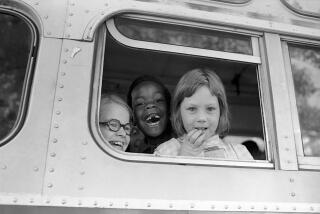Merging Families Need New Home to Call Own
- Share via
Marie has a house and kids. Bill has a house and kids too. Now they’re going to marry and take on one of life’s great challenges: blending families. So where should they all live?
Ideally, the newlyweds should resist the temptation to move the whole troop into either Bill’s or Marie’s home. Instead, they should find a third home where everyone in the blended family can make a fresh beginning, therapists and housing specialists agree.
“I vote for new for everybody,” said Carolyn Janik, the author of “Positive Moves,” a guide to relocation. Better that everyone in the blended family flex and change rather than making one group feel as if they are being invaded and the other like invaders, Janik said.
But the issue goes beyond fairness, said Dr. Susan Walen, a psychologist in private practice. If Marie’s family tries to move into Bill’s house or vice versa, there’s a danger that the new family will be contaminated by old memories.
“Often negative baggage from previous relationships can intrude on the fresh start,” Walen said.
Suppose, for instance, that everyone crowds into the red brick colonial where Marie moved with her former husband, John, a decade ago. This is a place that carries memories for Marie of her breakup with John. She may have trouble feeling optimistic about her new family life when she associates places in the home with the bitter recollections from her past.
By the same token, Marie’s 7-year-old daughter, Wendy, has undoubtedly staked out private spaces in the red brick colonial. She is accustomed to the middle seat in the kitchen nook and the small blue armchair in the family room with a good view of the TV. If interlopers were to challenge her control of these areas, her feelings could crumble.
Still, if Bill, Marie, Wendy and Wendy’s siblings and step-siblings all face the challenge of accommodating to a new space, no one runs the risk of feeling that his personal turf has been invaded, Walen said. While there will still be the turf issues, no one has emotional claims on particular areas.
“Moving the merged family into a place where no one has a history can be extremely important and can add to the emotional well-being of everyone,” says Dorcas Helfant, a realty executive and president-elect of the National Assn. of Realtors.
Beyond suggesting a move into a fresh environment, experts offer these housing pointers for blended families:
--Compromise on location, factoring schools into your decision.
The idea here is that it is often better to have both parts of the merging family make a sacrifice on location rather than having one bear the brunt of the move. However, you will want to take into account the work locations of both husband and wife.
And beyond that, the children’s schools can be a critical factor to consider.
Suppose you have two sets of children with two distant school systems involved in the family merger. Assuming one set must change schools, it is usually smart to change the younger children’s schools rather than uprooting older children from school-based relationships they have formed in their pre-teen and teen years, said Dr. James McGee, a clinical psychologist.
“The elementary school guys--if handled properly--can make the switch more easily,” he said.
Of course, there are exceptions, Walen noted. A young child with a learning disability might need the continuity of staying in the same special elementary school. On the other hand, a troubled adolescent who has fallen into the wrong social group could actually benefit by being uprooted from his old high school, she said.
--Give the merging family the biggest house you can afford.
“My husband and I bought a huge, six-bedroom house when we blended our families,” recalled Helfant, who helped merge two households involving four offspring 5, 17, 20 and 25--as well as a live-in housekeeper.
The chore of merging two families into one was one of the hardest tasks that she has ever undertaken, Helfant said.
But the combination of planning, teamwork among all the players involved and the purchase of a big house made the transition a positive one, she says.
Even though the older offspring involved in the family merger may stay only a short time, a large home allows them the psychological comfort of ample privacy and individual space while they’re there, Helfant said.
The large home, even though sold after only a few years, can provide the right setting to create a sense of emotional well-being that can endure for years and smooth over the difficulties of new relationships.
Whenever financially feasible, Helfant urges that a blended family seek a home that allows each young person to have a bedroom of his or her own--even if that young person is already away at college and only comes home on weekends, or is soon expected to move away.
“Where you reside when you merge families can have a lot of impact on emotional well-being and the ability of the family to unify and start out with a clean slate,” she said.
Distributed by Los Angeles Times-Washington Post News Service
More to Read
Sign up for Essential California
The most important California stories and recommendations in your inbox every morning.
You may occasionally receive promotional content from the Los Angeles Times.












